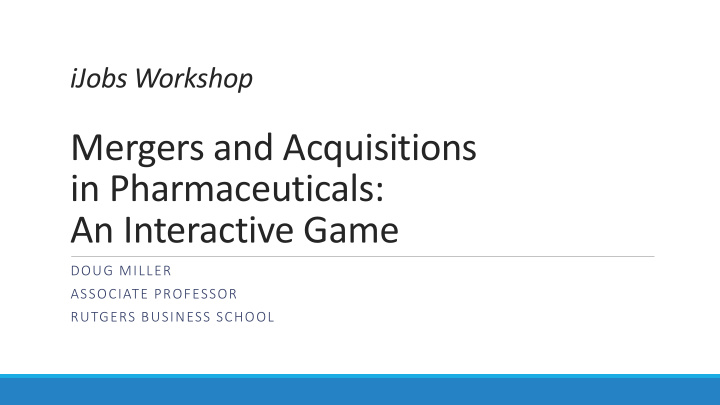



iJobs Workshop Mergers and Acquisitions in Pharmaceuticals: An Interactive Game DOUG MILLER ASSOCIATE PROFESSOR RUTGERS BUSINESS SCHOOL
Game Trees Modeling competitive decisions Start from the beginning: Decisions go in the order they happen Identify all relevant players – whoever has a choice to make Branches of decision tree should include all potential outcomes for each choice/decision Consider what the payoffs will be for each competitor in each situation Solving the game: backward induction Start from the end: identify the most attractive option (highest payoff) for each player, and eliminate the less attractive options
Problems in Valuation Difficulty with private or international firms Stand-alone price vs. changes in target vs. changes in acquirer How long will it take to achieve synergies? Lack of industry knowledge, poor due diligence
Escalating commitment Loss of reputation (perceived) Overconfidence Framing bias (may not get another chance) Broker incentives Impending market downturn Structure and people changes
Misunderstanding the rules What if the seller: • Opens another round? • Decides to wait? • Finds another bidder? What if regulators: • Take six months to make a decision? • Force you to sell off one of your current subsidiaries? • Deny the deal? What if investors: • Drop your stock price 10%? • Begin shareholder activism?
Value of M&A deals in biotechnology and pharmaceuticals sector worldwide from 1985 to 2018 (in billion U.S. dollars) 501 B Value in billion U.S. dollars '85 '86 '87 '88 '89 '90 '91 '92 '93 '94 '95 '96 '97 '98 '99 '00 '01 '02 '03 '04 '05 '06 '07 '08 '09 '10 '11 '12 '13 '14 '15 '16 '17 '18 Note: Worldwide; 1985 to 2018; Further information regarding this statistic can be found on page 8. Source(s): Institute for Mergers, Acquisitions and Alliances (IMAA) ; ID 965879
Largest pharmaceutical industry mergers and acquisitions ever worldwide until early 2019 (in billion U.S. dollars) Deal value in billion U.S. dollars 0 10 20 30 40 50 60 70 80 90 100 Warner-Lambert (Pfizer, 1999) 87.3 Celgene (Bristol-Myers Squibb, 2019)* 74 Aventis SA (Sanofi, 2004) 73.5 Target (acquirer, year) SmithKline Beechan (Glaxo, 2000) 72.4 Actavis (Allergan, 2015) 65 Pharmacia corp (Pfizer, 2002) 64.3 Wyeth (Pfizer, 2009) 64.2 Shire (Takeda, 2018) 62 Note: Worldwide; as of February 2019; Further information regarding this statistic can be found on page 8. Source(s): Bloomberg; Forbes; ID 518674
Highest premiums paid as of Feb. 2015 Acquirer Target Date Price ($B) Premium 1. Gilead Sciences Pharmasset Nov. 2011 $11 89% 2. Cardinal Health Allegiance Corp. Oct. 1998 $6.4 67% 3. Takeda Pharmaceutical Co. Millennium Pharmaceuticals Apr. 2008 $8.4 53% 4. Pfizer Hospira Feb. 2015 $17 39% 5. Pfizer Pharmacia July 2002 $59.8 38% 6. Amgen ONYX Pharmaceuticals June 2013 $10.2 38% 7. Roche InterMune Aug. 2014 $8.4 38% 8. Merck Cubist Pharmaceuticals Dec. 2014 $9.5 37% 9. Merck Schering-Plough Corp. Mar. 2009 $53.9 34% 10. Hologic Cytyc Corp. May 2007 $6 33%
Recommend
More recommend